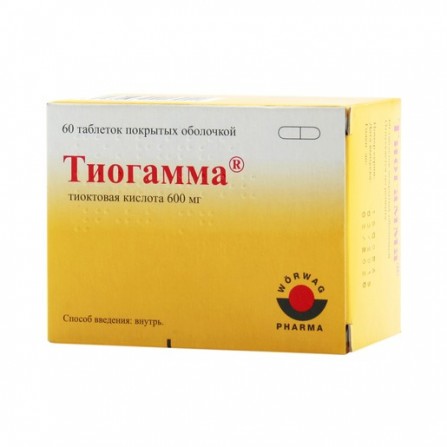Thiogamma coated pills 600mg N60
Condition: New product
1000 Items
Rating:
Be the first to write a review!

More info
Active ingredients
Thioctic acid
Release form
Pills
Composition
1 tablet contains: Thioctic acid 600 mg. Auxiliary substances: hypromellose - 25 mg, colloidal silicon dioxide - 25 mg, microcrystalline cellulose - 49 mg, lactose monohydrate - 49 mg, carmellose sodium - 16 mg, talc - 36.364 mg, simethicone (dimethicone and colloidal silicon dioxide in the ratio of 94: 6) - 3.636 mg, magnesium stearate - 16 mg. The composition of the shell: macrogol 6000 - 0.6 mg, hypromellose - 2.8 mg, talc - 2 mg, sodium lauryl sulfate - 0.025 mg.
Pharmacological effect
Metabolic drug. Thioctic (α-lipoic) acid is an endogenous antioxidant (binds free radicals), is synthesized in the body during the oxidative decarboxylation of alpha keto acids. As a coenzyme, mitochondrial multienzyme complexes are involved in the oxidative decarboxylation of pyruvic acid and alpha-keto acids. Helps reduce the concentration of glucose in the blood and increase the glycogen content in the liver, as well as overcome insulin resistance. It participates in the regulation of lipid and carbohydrate metabolism, affects cholesterol metabolism, improves liver function, has a detoxification effect in poisoning with heavy metal salts and other intoxications. It has a hepatoprotective, hypolipidemic, hypocholesterolemic and hypoglycemic effect. It improves neuronal trophism. In diabetes mellitus, thioctic acid improves endoneural blood flow, increases glutathione content to a physiological value, which results in an improvement in the functional state of peripheral nerve fibers in diabetic polyneuropathy.
Pharmacokinetics
AbsorptionAfter ingestion, thioctic acid is rapidly and almost completely absorbed from the gastrointestinal tract. When taken with food absorption decreases. The time to reach Cmax (4 mcg / ml) is about 30 minutes. Bioavailability is 30-60% due to the effect of the first passage through the liver. Metabolism Metabolized in the liver by oxidation of the side chain and conjugation. Excretion Thioctic acid and its metabolites are excreted by the kidneys (80-90%), in small quantities - in unchanged form. T1 / 2 is 25 minutes.
Indications
- diabetic polyneuropathy; - alcoholic polyneuropathy.
Contraindications
- pregnancy; - lactation period (breastfeeding); - children's age up to 18 years; - hereditary intolerance to galactose, lactase deficiency or glucose-galactose malabsorption; - hypersensitivity to thioctic acid or other components of the drug.
Precautionary measures
Patients taking the drug Thiogamma, should refrain from alcohol.
Use during pregnancy and lactation
The use of the drug Tiogamma is contraindicated during pregnancy and lactation (breastfeeding).
Dosage and administration
Assign inside 600 mg (1 tab.) 1 time / day. Tablets are taken on an empty stomach, without chewing, with a small amount of liquid. The duration of treatment is 30-60 days depending on the severity of the disease. Possible repetition of treatment 2-3 times a year.
Side effects
The following side effects are very rare (<1/10 000): On the part of the digestive system: nausea, vomiting, abdominal pain, diarrhea. Allergic reactions: systemic reactions (up to the development of anaphylactic shock), skin rash, urticaria, pruritus. CNS: a change or a violation of taste. From the endocrine system: due to improved glucose uptake, a decrease in blood glucose concentration is possible. This may cause symptoms of hypoglycemia - dizziness, increased sweating, headache, visual disturbances.
Overdose
Symptoms: nausea, vomiting, headache. In the case of receiving from 10 to 40 g of thioctic acid in combination with alcohol, there were cases of intoxication, even death. Symptoms of acute overdose: psychomotor agitation or confusion, as a rule, with the subsequent development of generalized seizures and the formation of lactic acidosis. It also describes cases of hypoglycemia, shock, rhabdomyolysis, hemolysis, disseminated intravascular coagulation, bone marrow suppression and multiorgan failure. Treatment: symptomatic therapy is carried out. There is no specific antidote.
Interaction with other drugs
Thioctic acid enhances the anti-inflammatory effect of GCS. With the simultaneous administration of thioctic acid and cisplatin, a decrease in the effectiveness of cisplatin is noted. Thioctic acid binds metals,therefore, it should not be administered concurrently with preparations containing metals (for example, preparations of iron, magnesium, calcium) - the interval between doses should be at least 2 hours. With simultaneous use of thioctic acid and insulin or oral hypoglycemic drugs, their effect may be enhanced. Ethanol and its metabolites weaken the action of thioctic acid.
special instructions
Patients with rare hereditary fructose intolerance, glucose / galactose malabsorption syndrome or glucose isomaltase deficiency should not take Tiogamma. Patients with diabetes mellitus during the treatment period with Thiogamma, especially at the beginning of therapy, should monitor blood glucose levels. In some cases, it may be necessary to adjust the dose of insulin or oral hypoglycemic drug in order to avoid hypoglycemia. Alcohol consumption during therapy with Thiogamma reduces the therapeutic effect and is a risk factor contributing to the development and progression of neuropathy.1 A tablet of Thiogamma 600 mg contains less than 0.0041 XE. Effect on the ability to drive a motor vehicle and to control the mechanisms. The admission of the drug Thiogamma does not affect the ability to drive vehicles and otu with other mechanisms.




